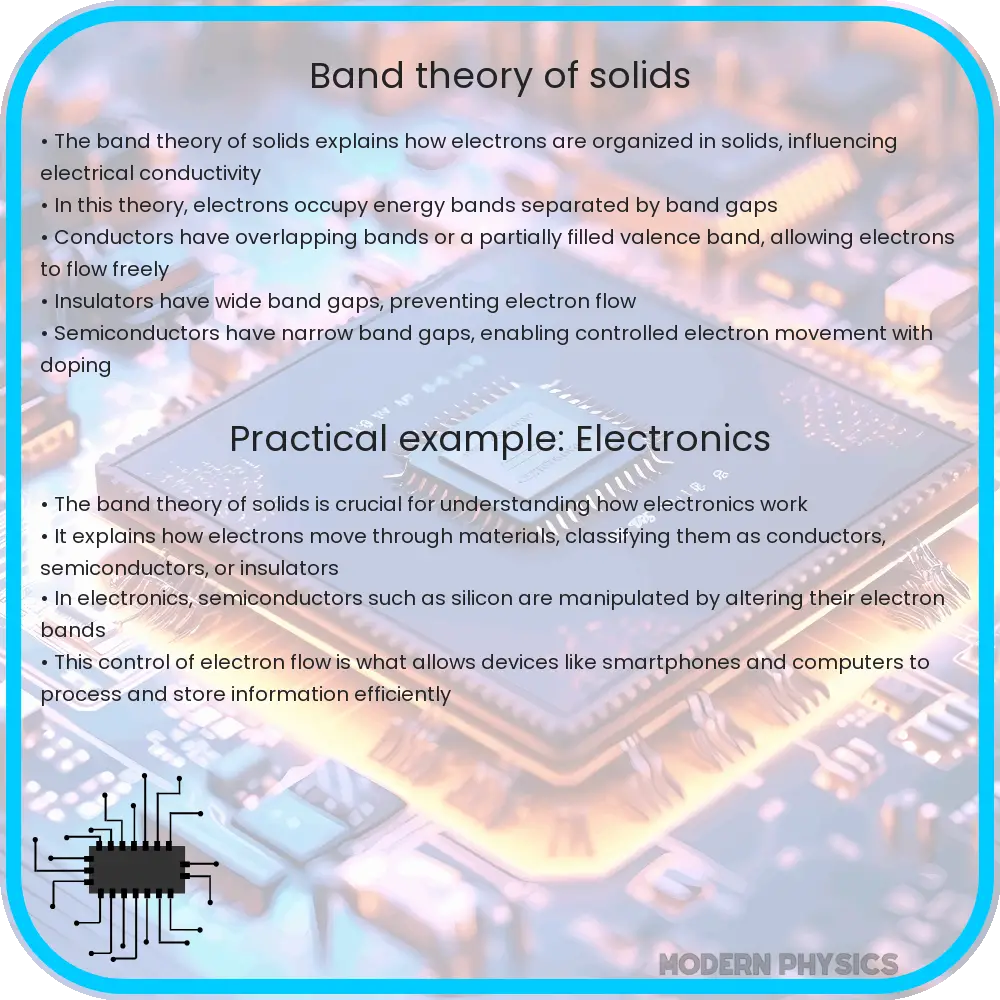Explore the essentials of Band Theory of Solids, its impact on conductors, semiconductors, insulators, and its key role in advancing technology.

Understanding Band Theory of Solids
Band theory of solids is a fundamental concept in solid-state physics that explains the electrical, thermal, and optical properties of materials. It is based on the quantum theory of atoms and molecules, illustrating how atoms in a solid interact to form bands of energy levels, which in turn influence the material’s conductivity. This theory is pivotal for understanding the behavior of conductors, semiconductors, and insulators.
Key Concepts of Band Theory
At the heart of band theory are several key concepts that define the behavior of electrons in a solid:
- Energy Bands: When atoms form a solid, their closely spaced discrete energy levels merge into continuous bands. These bands are separated by energy gaps known as band gaps.
- Band Gap: The energy difference between the top of the valence band and the bottom of the conduction band. It is crucial in determining a material’s electrical conductivity.
- Valence Band: The highest energy band that is fully occupied by electrons at absolute zero temperature.
- Conduction Band: The band immediately above the valence band, which is partially filled with electrons or completely empty, allowing for electrical conductivity.
Materials can be classified based on their band gap:
- Conductors: Metals have overlapping valence and conduction bands, allowing electrons to flow freely and conduct electricity efficiently.
- Semiconductors: These materials have a small band gap that electrons can overcome at room temperature, making them partially conductive.
- Insulators: Characterized by a large band gap, insulators prevent electron flow, making them poor conductors of electricity.
Applications of Band Theory
Band theory underpins the operation of a vast array of electronic devices and materials:
- Semiconductors: The foundation of modern electronics, semiconductors like silicon (Si) and gallium arsenide (GaAs) are essential for manufacturing integrated circuits, transistors, and solar cells.
- Insulators: Materials with large band gaps, such as diamond (C) and silicon dioxide (SiO2), are used in applications requiring high electrical resistance and thermal conductivity.
The versatility of band theory extends beyond just understanding the electrical properties of materials. It also plays a critical role in the development of optical devices and thermoelectric materials. For instance, the optical properties of materials, such as their ability to absorb, reflect, or transmit light, are dictated by the electronic transitions between different energy bands. This principle is exploited in photovoltaic cells and LED technology, where band theory guides the design of materials that efficiently convert light into electricity or vice versa.
Furthermore, band theory is instrumental in the study of thermoelectric materials, which convert temperature differences into electrical voltage and vice versa. By analyzing the band structure of these materials, scientists can optimize their efficiency for energy conversion, contributing to the development of sustainable energy technologies.
Advanced computational methods in quantum mechanics, such as density functional theory (DFT), have enabled more precise predictions and analyses of band structures in complex materials. These computational tools help in designing new materials with tailored electronic properties for specific applications, pushing the boundaries of what is possible in electronics, photonics, and energy technology.
Conclusion
Band theory of solids provides a comprehensive framework for understanding the electronic structure and properties of materials. From the basic classification of materials into conductors, semiconductors, and insulators, to the sophisticated design and optimization of electronic and optical devices, band theory is a cornerstone of modern physics and materials science. Its applications in semiconductors, insulators, and beyond highlight the theory’s significance in the advancement of technology and its pivotal role in the development of new, innovative materials. As research and technology continue to evolve, the principles of band theory will remain essential in guiding the discovery and application of materials that meet the ever-changing demands of society.
